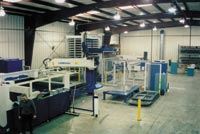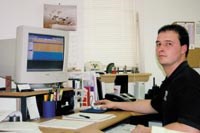Real-Time Data Collection For Real-Time Customer Response
Keeping track of orders, materials, machines, tools, processes, employees and costs is an enormous task for any shop. That is why shopfloor management software has become a major factor in manufacturing operations.
Share









Autodesk, Inc.
Featured Content
View More


Takumi USA
Featured Content
View MoreAs today’s customers demand more than a quality part delivered on time, increasingly suppliers are required to keep documentation and traceability, as well as provide job status on a minute’s notice. Keeping track of orders, materials, machines, tools, processes, employees and costs is an enormous task for any shop. That is why shopfloor management software has become a major factor in manufacturing operations. And while ease-of-use, automated data collection and real-time reports are important innovations of the 90s, the innovations of this new decade will tie operations and communications so closely together that there will be little to separate customers and vendors other than location.
KVK Precision Specialties, located in Shenandoah, Virginia, provides a good example of current shopfloor management software implementation and discloses some insight into the very near future. This year, KVK was recognized by the state of Virginia as the state’s 28th fastest growing privately owned business with a growth average of 287 percent during the past four years.
“Thirty percent of our growth is because our management software has put us in a position to quickly quote and respond with our customers,” says Jeff Vaughan, CEO and president of KVK. “That’s extremely important. Customers want their parts now. They want them right. They do not want to keep or maintain inventory. We don’t either. So we have to maintain the shortest cycle possible. That requires software.” Smart Manager software is the management tool that KVK has implemented to keep track of order entry and accounting, as well as keep production moving and customers advised of status.
KVK began in 1977, and it now has 68 employees, a 78,000-square foot facility, and 36 CNC machines. These machines include Mori Seiki VMCs and HMCs and Mori and Mazak turning centers. Recently, a $2-million dollar investment was completed in a new facility that houses an unattended punch, laser cutting and bending operation. The facility includes a Trumpf punch machine and four-axis laser. It’s all integrated with vertical storage, which feeds material to both machines unattended with no human intervention.
In addition to its job shop operations, KVK has a contract with General Electric to manufacture, assemble and deliver industrial drive components direct to its customers. KVK handles the entire manufacturing and assembly process. The company procures castings, does machining, assembly, and testing. Finishing operations, such as painting, packaging and preparing operating instructions are also handled by the company.
“When we first started using the software, our people were technically oriented with the shop floor, but not computer gurus. We wanted software that made it easy to locate a particular purchase order to determine quantity, due date and where the job is in the shop,” says Mr. Vaughan.
All of the software’s capabilities, which include order entry, scheduling, resource planning, real-time tracking, inventory of more than 4,000 component parts and imaging capabilities are utilized. The software tracks a job from the time a purchase order is received until the product is shipped to the customer. The documentation and traceability provided by the software help to communicate the complete manufacturing process to customers. This includes external issues, such as quality of raw materials and vendor rating, as well as internal processes.
“We would not have been able to manage the GE contract if we didn’t have software to control and manage our operation,” says Mr. Vaughan. “The software delivers documentation of our procedures, which is going to make the process of ISO 9002 certification easier for us because our operations have already been identified. We just need to detail them.”
Bar code scanners throughout the shop facilitate automated data collection, which enables the software to keep track of every job in real time as it moves through the shop. From the captured data, reports can be generated that rate employee and vendor proficiency, as well as machine utilization, as it happens. These reports enable managers to determine the shop’s capacity for additional work. Also, a machine utilization report identifies machine issues, such as too much downtime, so it can either be repaired or replaced. In addition, custom reports can be generated that track shipments and rate vendors.
“Because we’ve become so organized, our people have become very disciplined in procedures, which has made implementation of new software features and reports easier,” says Mr. Vaughan. “When a customer visits our shop to audit order processing and manufacturing, the software makes it easier to comply. We show customers documentation that includes certification of material, when the material was received, who the vendors are, as well as how we rate them by quality of product and on time delivery. We’re able to deliver that information with a keystroke.”
KVK is now in the process of implementing the imaging capabilities of the system. These features enable photographs of the work fixture and the area where the job was last set up to be stored in the software. The images can be retrieved at any terminal so that supervisors and machine operators find out how the job was set up the last time it ran.
Manufacturing management technology is rapidly changing, according to Mr. Vaughan. If manufacturers can keep up with the investment required to upgrade and implement technology, the Internet will have a major impact on managing the shop floor, he believes. For example, Trumpf is able to dial into the PC control on KVK’s punch press and observe the ladder logic and binary code to determine what is correctly and incorrectly functioning. When software revisions are needed, they will be downloaded from the Internet.
“We are very rapidly heading to Internet connections at a machine tool allowing the operator to pull up the workpiece drawing from a customer’s location,” says Mr. Vaughan. “Already, we store and retrieve drawings from our software. Once it operates on the Internet, information will be available to customers. And they will be able to connect with our software over the Internet and determine job status in real time without even a phone call. They’ll be able to determine if we can meet their ship date and, if necessary, advise us that it needs to be expedited.”
One of the big questions is how deeply customers should be allowed into the software, not only from a security standpoint, but also regarding what information they should know. Mr. Vaughan points out that, with a good system for job costing, there shouldn’t be a problem, because a contract specifies the shop rate. This should help customers to understand what is involved in the manufacture of their parts, he believes.
“In the near future, the communication level is going to tighten the supplier chain very closely,” says Mr. Vaughan. “Customers are going to have immediate access to the information about their parts from the beginning to the end, from raw material or blank casting to finished component. We’re located in a very rural location, and the combination of shop floor management software and the Internet will enable us to reach any location to communicate with customers and suppliers.” MMS
About the author. Michael Maloof is vice president of product development at Smart Shop Software Inc.
Related Content
ERP Provides Smooth Pathway to Data Security
With the CMMC data security standards looming, machine shops serving the defense industry can turn to ERP to keep business moving.
Read MoreHow this Job Shop Grew Capacity Without Expanding Footprint
This shop relies on digital solutions to grow their manufacturing business. With this approach, W.A. Pfeiffer has achieved seamless end-to-end connectivity, shorter lead times and increased throughput.
Read MoreCan AI Replace Programmers? Writers Face a Similar Question
The answer is the same in both cases. Artificial intelligence performs sophisticated tasks, but falls short of delivering on the fullness of what the work entails.
Read MoreCan ChatGPT Create Usable G-Code Programs?
Since its debut in late 2022, ChatGPT has been used in many situations, from writing stories to writing code, including G-code. But is it useful to shops? We asked a CAM expert for his thoughts.
Read MoreRead Next
Registration Now Open for the Precision Machining Technology Show (PMTS) 2025
The precision machining industry’s premier event returns to Cleveland, OH, April 1-3.
Read More































.jpg;maxWidth=300;quality=90)









